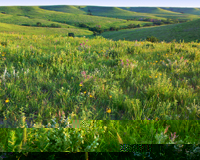THE ECOLOGICAL QUESTIONHow do site characteristics (topography and soil depth), fire frequency, and climate interact to influence plant productivity in the tallgrass prairie? ECOLOGICAL CONTENTpatterns and controls of aboveground net primary productivity (ANPP), climate, fire, forbs, grasses, limiting factors, long-term data, tallgrass prairie, topography WHAT STUDENTS DOThis Data Set allows students to compare the interactive effects of fire frequency, topography and inter-annual variation in precipitation on the annual productivity of two major plant groups — grasses and forbs — in the tallgrass prairie. In this exercise, students work with data on aboveground productivity in a tallgrass prairie and annual precipitation for 1984-1999. Using these data, students create figures to examine the relationships between plant productivity and precipitation, fire, topography. The plant productivity data are divided into two vegetation types (grasses and forbs; forbs are any non-woody, non-grass vascular plant), two topographical positions (uplands and lowlands), and three fire frequencies (annual, 4-yr, and 20-yr burns, respectively). As the students explore these relationships they will develop an understanding of how fire, topography, and precipitation influence tallgrass prairie productivity and how these factors vary over time. At the completion of the exercise, students discuss their interpretations and submit answers to questions developed while creating figures to explore these relationships. SKILLSStudents create multiple figures using spreadsheet and graphing software. To accurately interpret the results, students must critically think about plant-ecosystem relationships, determine sources of variation influencing productivity, and use this understanding to predict temporal patterns of productivity. ASSESSABLE OUTCOMESFigures (bar and line graphs) created by the students and the written interpretation of the relationships shown in the graphs. SOURCEKonza Prairie Biological Station Long-Term Ecological Research online archives: 1984-1999 http://www.konza.ksu.edu AUTHORSJesse Nippert1 and John Blair2 1 - Department of Biology, Colorado State University, Fort Collins, CO 80523, nippert@lamar.colostate.edu 2 - Division of Biology, Kansas State University, Manhattan, KS 66506, jblair@ksu.edu ACKNOWLEDGMENTSAt field stations that continually archive ecological data, the success of scientists, graduate students, and researchers is in large part due to the tireless efforts of the personnel and field workers who collect, sort, and quantify data year after year. The Konza Prairie Biological Station is no exception, and this exercise would not be possible without the efforts of Rosemary Ramundo, Amanda Kuhl, and their army of undergraduate workers too numerous to name. Additionally, I would like to thank Charlene D’Avanzo for assistance and encouragement while preparing this exercise and John Briggs and Alan Knapp for helpful comments and discussions. CITATIONNippert, Jesse and John Blair. March 2005, posting date. |

Konza Prairie Landscape
Copyrighted by: Judd Patterson |